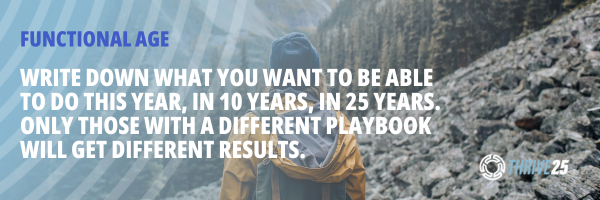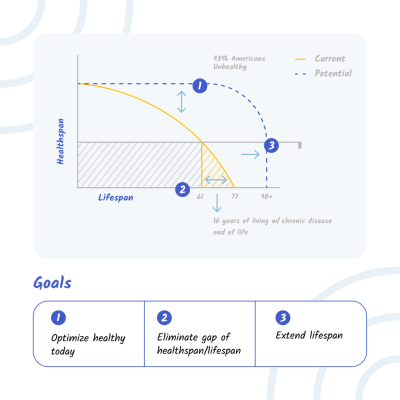Issue #285: Functional Age Over Biological Age
Good morning. It’s Tuesday, January 2nd.
New Year = New Look. We’ve revamped our newsletter to give you more of what you want.
Oh and if you don’t want to read it - you don’t have to. We now have an audio version of the newsletter. Check it out below.
Here’s to health & longevity in 2024!!
In today’s email:
Learn: Functional Age
Try: The Cooper Test
Measure: Blood Pressure
In the News: Genetically-Enhanced Human
Pro Tip: If listening on Spotify or iHeartRadio - use your usual podcast speed (e.g., 1.25x or 1.5x) for optimal audio experience
Stat of the Day
The percentage of Americans with elevated or high blood pressure - but most people don’t even know it. (source)
Learn
Functional Age
There’s been a lot of talk lately about biological age tests. While I think this science will improve and help us personalize our own protocols in the future, today these tests aren’t very actionable and have significant limitations.
I’m much more focused on FUNCTIONAL AGE.
I don’t care that I’m going to turn 43 this year - I care if I can still run a 10K race, surf 5 ft waves, ski black diamonds, and not think twice about tackling a 10-mile hike up a few thousand feet when we travel to a National Park.
I know this is the same for many of our readers:
54% of you told us you want to be “at least in the top 20% for your age when it comes to health”
36% of you want to make sure “health doesn’t get in the way” of the life you want to live
That’s why it’s not surprising that fitness is the #1 new year’s resolution for 2024.
48% of everyone that set a resolution want to get in better physical shape (compared to 38% improved finances, 36% improved mental health).
How we move today will determine how we live tomorrow.
Don’t be like the majority of people that just say “I’m going to workout more this year” and then give up on that goal by mid-Feb.
To create the right plan -
Set your baseline - identify and record what you can do right now
Set your goal/intention - what do you want to be able to do today, in 10 years, in 25 years
Be realistic - commit to a plan that fits with your schedule and gets you to your goal(s)
The baseline helps you measure if you’re trying to maintain or improve your fitness.
The goal isn’t so much about exercise (wanting to run a 20-min 5K), as much as what you want to be able to do to live the most fulfilling life (like that commercial we shared in Issue #282).
The plan has to be something you’ll actually stick with - if you don’t enjoy the process you’ll just be setting the same goal next year with no progress.
Try
Benchmark Your Metabolic Fitness
There are some great biomarkers here - like VO2Max. But again, we’re focused on functional age - what can I actually do.
Running Test: If you run - do a warm-up (dynamic stretching and then a half-mile to mile jog) and then run 1.5 miles as fast as you can without getting injured.
The purpose isn’t just to have the best time - it’s to set the baseline so you can set the right goal to maintain or improve on this time.
Here’s a reference table from the Mayo Clinic - achieving these results for your age and gender are associated with lower risk for heart disease. But remember - this is a race against yourself, no one else:
Alternative: If you’re not a runner or can’t run - you can also get a good baseline from a test on a bike (preferably a stationary bike). Called the Cooper Test, named after Kenneth Cooper, you do a warm-up and then try to max out your distance as far as you can go in 12 minutes.
Fitness scores by age and gender:
Thrive25 Partner Spotlight
In December, Max completed the TMAC Fitness 8-week Get Strong From Home challenge - and he can’t stop talking about it! Every workout is approachable and includes a meditation, and there’s the right cadence of bodyweight HIIT, cardio flush, strength training and yoga. For a limited time, check out the workouts for FREE.
Take the first step towards a fitter, more balanced you! Get 10 days of FREE access to the workout library by clicking HERE!
Measure
Blood Pressure
The top request from our community was to highlight a specific biomarker in the newsletter. So every Tuesday we’re going to include one metric that significantly impacts our health. We’ll do our best to explain in layman’s terms and to include only the practical advice you need to know.
We’re starting with one of the most important - blood pressure. We all get this measured every time we go to the doctor’s office. But do we really know what those numbers mean and what we can do to get the best results? Let’s dig in.
Blood pressure is the force put on the walls of our blood vessels (our endothelium) every time our heart pumps. It’s one of the top vital signs to determine if we’re going to have future cardiovascular problems. Why? Well the more pressure we put on our endothelium, the more potential for damage to our blood vessels - then we get blockages or low blood flow.
Risks
It’s called the “silent killer” because high blood pressure isn’t something we can see or feel - which is why it’s essential to get this checked at least every year.
The three organs most at risk from high blood pressure are the heart (obviously), the brain, and kidneys. The heart and brain can’t function without consistent, adequate blood flow - leading to a heart attack or stroke. But it’s not just immediate problems - there is even an association with high blood pressure and Alzheimer’s Disease from the long-term effects of too little blood and oxygen making it into the brain.
As for the kidneys - they represent only 2% of our body weight, but receive 20-25% of our blood. Our kidneys filter 150 quarts of blood every day. High blood pressure and damaged blood vessels can cause kidney disease.
The Test
Cost: $0, included at any visit to a doctor’s office
Prep: Rest for 5 minutes before and go to the bathroom - apparently a full bladder can skew results
Reliability: 95+% at the doctor’s office. The accuracy of OTC blood pressure monitors, cuffs and watches vary
Frequency: at least annually
Key Tips for Accuracy*: Make sure you or your doctor puts the cuff under all clothing. During the test - sit with feet/back supported, don’t talk, don’t cross your legs, and keep your arm at heart level.
* Your blood pressure fluctuates based on your activities/stress, so it is a point in time measurement. If you are naturally stressed going to the doctor, your result will be higher
Your Results
Unit of measure: millimeters of mercury (mm Hg) because why not (the first instrument to measure blood pressure was a mercury column)
Why Two Numbers?: The first number (systolic) measures the pressure on our blood vessels when the heart pumps blood out into our body. The second number (diastolic) measures the pressure on our blood vessels when the heart relaxes and takes in new blood.
Optimal range: Systolic = 90-120 mm Hg, Diastolic = 60-80 mm Hg. The systolic pressure is often listed first, this is why you tend to hear 120 over 80 or 120/80 as normal/optimal
Stay in Range
First - you don’t want to even be in the yellow. If you’re above 120/80, make changes to your lifestyle (see below) and, if necessary, contact your medical professional.
If your blood pressure is high (hypertension):
The number one solution is exercise - specifically Zone 2 training. Try to get a minimum of 3 hours a week of activity where you can still talk, but are exerting 60-75% of total effort
Focus on reducing your waist circumference (visceral fat)
The vagus nerve controls our parasympathetic nervous system (rest & digest) and can lower our blood pressure. Try stress management through meditation, breathwork or even silence
Some studies suggest eating potassium-rich foods like bananas can lower blood pressure
Get consistent, high-quality sleep
If your blood pressure is low (hypotension) - typically below 90/60, but if you consistently feel faint don’t worry about the actual number:
Drink fluids, preferably water
Avoid alcohol and coffee
Wear compression stockings to keep blood from collecting in the legs
Manage any medications if prescribed
In the News
Genetically Enhanced: Bryan Johnson (Issue #115) spends $2M per year to stop aging. The journey continues as he recently traveled to the Caribbean for his first $25K follistatin gene therapy dose (not FDA-approved). (Business Insider)
Are You a Climatarian?: Sustainable cooking and related cookbooks have been around for a while, but are gaining speed in the mainstream with more and more people looking for ways to combat climate change. (WIRED)
Cancerphobia: Fear can distort anything - remember perception shapes reality. We tend to be more afraid of human-created compared to naturally occurring risks, but they are equal. (Big Think)
Thanks for joining us today!
Check out the latest workout videos on our YouTube channel
Got feedback, recommendations or stories to share? Tell us what’s on your mind here
Want this direct to your inbox? Sign up here
Why Thrive25
We’re 40-something dads that felt our bodies and minds start to slow down and we’re not ready for that. We found too much information on every subject. So we started Thrive25 to transform what we’ve learned into something useful for the rest of us to spend just 3-5 min a day to optimize our health & longevity.
This newsletter is for you and we truly value your feedback. Never hesitate to reach out to us at team@thrive25.com.
To health!
Sign up for free:
The information in this newsletter is for informational purposes only and may not be appropriate or applicable based on your individual circumstances. Thrive25 Labs, Inc. does not provide medical, professional, or licensed advice. Please connect with your healthcare professional for medical advice specific to your health needs.











